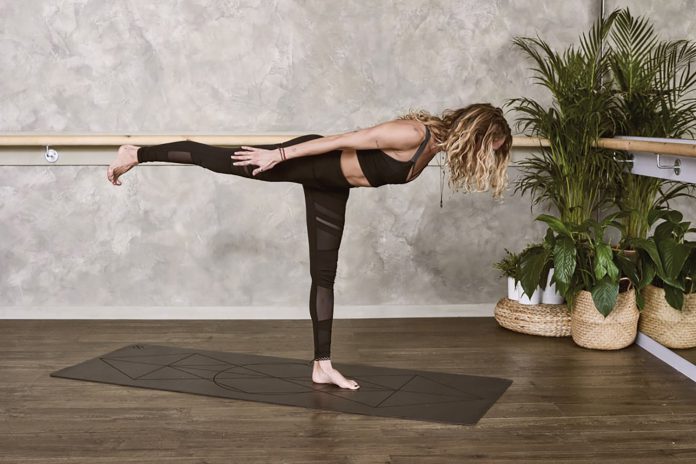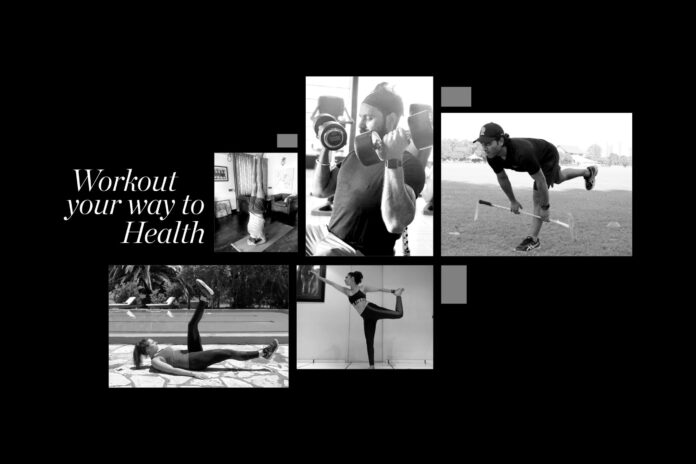There’s been no getting away from it. The world has taken a pause to beat Covid-19, and only essential services are running. With multiple shifts in programs and disruptions in schedules, it’s important to beat stress and anxiety with a regular fitness routine.
Sticking to fitness plans have been most important for professional sportsmen, athletes and actors. Even the general population, confined to homes, would benefit greatly by taking small walks or doing their favourite exercises.
LA POLO spoke to health and sports experts. The break in polo schedules and the lack of competitions have had emotional and psychological impacts. Chukka Wellness and Coach Ajay Singh, along with other professionals, have been engaged with keeping fit during these stressful times.
Simran Singh Shergill, +6 handicap player, was honored with the prestigious Arjuna Award in 2019 for his contribution to the world of Polo. Talking about his fitness, he said: “I have been doing full body workouts. You must work the legs, core, upper body and coordination and also reflexes. I am not good with weights and so functional exercises work best for me. I go for squats, planks, push-ups, crunches and reflexes for coordination.”
India Parker-Smith founded Chukka Wellness to help Polo players get fitter and stronger. For several years, Parker-Smith worked as Personal Trainer at one of Chelsea’s premier private members’ clubs and began to train some of the world’s leading sportsmen and women. Parker-Smith trains both international and UK Polo professionals focusing not only on functional movements and body maintenance, but also advising them on fuelling their bodies correctly for mental alertness and physical endurance.
Chukka Wellness suggests the following five quick and essential exercises to keep the players fit. Make sure to properly warm up and stretch before and after the workouts:
1. V-sit Start sitting down with hands on the ground and get your feet up. Engage your abdominal muscles, flex your elbows back and extend your legs away from your body. Then flex the legs back into your chest as you fully extend the arms back up to the starting position.
2. Side Plank with Rotations Start inside plank position with your elbow directly underneath your shoulder and hips high. Keeping the hips and bottom knee off the ground, bring your top arm down, underneath your torso and twist.
3. Heel Taps Start on your back and lift your legs up until there is a 90-degree bend. Push your lower back into the ground and engage your abdominal muscles. Keeping a bend in the knees, slowly drop one heel down to the ground, tapping it lightly. Then bring the leg back up to the start position. Switch legs.
4. High Reaches Start in the same position as the heel taps but raise your head and shoulders off the ground and reach your toes with your hands. Pause for a second; then slowly lower your upper body back down to the ground.
5.Leg Raises Start on your back, brace your core and push your lower back into the ground. Elevate and extend your legs so that they are adjacent to your body and slowly lower one to the ground. Ensure you keep the core braced and the lower back drilled into the mat.
Another leading female polo player Rinaa Shah shared with us her daily routine to fitness through a video. Watch out!
Shyam Mehta, President, Amateur Riders’ Club, and an ardent Polo Player sticks to yoga. He said: “Yoga has been an essential fitness routine for me owing to its multiple health benefits. These days, I have a fixed routine of breathing exercises, meditation, and stretching for about 45 minutes in the morning and another 45 minutes of power yoga in the evening. Currently, I am at my farmhouse at Kalote, surrounded by mountains, so I get the chance to enjoy the fresh, unpolluted mountain air. Sometimes, I go for treks in the mountains surrounding my farmhouse which are totally isolated.”
Mehta spoke about the exercises that he practises to improve his horse-riding skills. “Each yoga asana and mudra improves my horse-riding and polo skills. Breathing exercises help me build stamina. Meditation helps me with my concentration and focus. Power yoga helps build the core muscles which are very important for sustained strength to ride the horse and to be able to hit all the shots in minimum reaction time. It’s hard to prescribe three quick exercises to improve one’s horse-riding skills, but if I must, I believe some stretching exercises, surya namaskar and navasana work best. Swimming is also an excellent option.”
To keep fit physically and mentally, a good diet is also important. Shyam Mehta says: “I eat only fruits for breakfast, usually one or more of a combination of apples, grapes, papayas, watermelons, bananas, pomegranates, and chikoos. Lunch and dinner comprises vegetables, eggs, chicken, and/or dal with rice or rotis. Sometimes, I have pasta. I avoid fried food. I prefer eating light and stopping once I’m 80 percent full.”
Lack of competition and sudden shutdown affects mental health. Mehta said: “I keep myself occupied with yoga, exercises, reading, attending online classes, cooking, gardening, and also do a bit of legal and ARC work. I haven’t felt the need to do binge watching on television. I’m busy with multiple activities, learning new things, maintaining social distancing and staying safe.”
Coach Ajay Singh gave his tips for players for strength and conditioning exercises polo players need at this time. He said: “Polo is about repeated force production But it’s not just legs and upper body, you also need a strong core to handle the horse and control the swing.”
Keep exercise selection simple in the beginning. Use exercises like squats, lunges or step-ups for the hips, thighs, and hamstrings back extensions for the lower back, and push-ups for the shoulders. After a few weeks, move to free weights or some resistance work use light dumbbell and barbell. Five exercises for polo players to do at home: 1. Push-ups 2. Squats 3. Planks 4. Sit-ups 5. Reverse lunges
Lunges Lunges target the quadriceps, hips, and hamstrings. You should start without weight to get comfortable with good form. Once you have it down, you can take dumbbells or kettlebells in your hands for added weight.
Squats Squats are a great off-season exercise. They work the glutes, hips, quads, and hamstrings. They help to improve strength as well as endurance. It’s essential to learn the proper technique with light weights.
Planks Planks are the best for core strength. They will work your abs, lower back, and shoulders. First work your way up to a 1-minute continuous plank with proper technique and then start adding variations. You can try lifting legs, one at a time or doing side planks to increase difficulty and work different aspects of the core.
It’s important to warm up your muscles properly before the game
We can do short warm-ups (10 mins) to raise the body temperature and start moving joints before getting on to the horse.
* Roll wrists and forearms · Rotate arms in one direction and then in another alternatively · Rotate hips · short jumps on the spot with legs either straight or bent · Slow and quick flexing · Kicks, Skips & Walks Mix-and-match five or more of the following:
Frankenstein Walks (Hamstrings): Keeping the right leg straight, raise it in front of you and touch your toes to your outstretched right hand. Step forward, land, and repeat with the left leg. · Lunge Walks. · Heel Walks (Calves): Walk forward balancing on the heels. · Other options: high-knee skips, high-knee runs, butt-kicks, straight-leg skips, straight-leg runs, and backward runs. · Resistance Band Work. Internal and external resistance band work is excellent for warming up shoulders as well as building shoulder strength. · Knee Hugs (Glutes & Hips). You’ve probably been on your horse for the better part of this year. It’s okay to take a week or two or three to rest. Ask yourself how you’re feeling at the end of the season. Are you burnt out? Does your body want to rest? How often were you sick or injured over the season? This helps prevent burnout, clears your mind, and allows your body to do different movements. You likely have some under-active and overactive muscles from doing the same movement every day for the past few months.
Over-training occurs in players who train well beyond their body’s ability to recover. Most of us are juggling family commitments, training and trying to fit in some social activities. It just isn’t possible to keep balancing all these things and something often cracks. Usually it is our health. Polo players may feel:
* tired
· lack of energy for other activities
· suffer from depression
· have decreased appetite
· headaches
· get an increased incidence of injuries
· have trouble sleeping
· feel a loss of enthusiasm for the sport
· experience a sudden drop in performance
There are many things you can do to help avoid overtraining. For ecample:
· Have a recovery day
· Get a massage, use compression garments, and/or elevate your legs
· Use water therapy, (hot/cold contrast), or go for a swim
· Eat well, get to bed early, stay hydrated and avoid alcohol
Good nutrition is crucial for health, particularly when the immune system might need to fight.
1. Eat a variety of fruits and vegetables daily. The goal is to eat at least five servings per day, and include varieties of fruit and vegetable colour. Fruits and vegetables are filled with the energy and nutrients necessary for training and recovery. Plus, these antioxidant-rich foods will help you combat illness like cold or flu.
2. Choose whole grain carbohydrates sources. Limit refined grains You'll benefit more from whole-grain products.
3. Choose healthy sources of protein such as chicken, pulses, fish, eggs, nuts and yogurt and milk.
4. Stick with whole food options as much as possible as opposed to highly processed foods.
Hydration
Adequate hydration is a key element in sports performance. Most athletes benefit from developing a personal hydration plan. A general rule for training is to consume a minimum of:
· Two cups of fluid prior to training.
· Four to six ounces of fluid every 15 minutes of exercise.
Coach Ajay Singh says: “We’ll get more serious later. Right now, take it easy. There is plenty of time to graduate to the more serious efforts at resistance training in the coming months. Let's hope we can turn this situation around, the quicker the better.”
Abhimanyu Pathak, the +5 handicap polo player, has often shared his fitness regime with LA POLO. He shows how players can still use their polo kits while they are off from the field and the actual game. Fondly known as Abby, he shares the act of balancing using the polo mallet. Balancing, undoubtedly is a must when it comes to the game of speed.
Shaurya Vikram displayed his skateboard skills, breaking the stereotype exercise regime.




